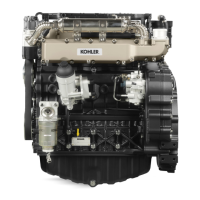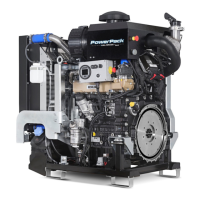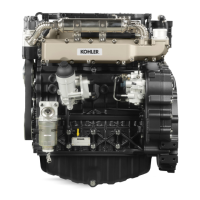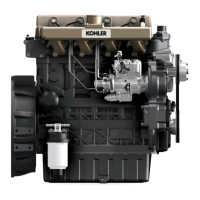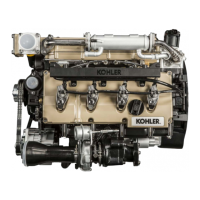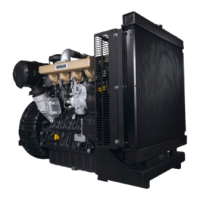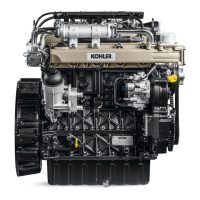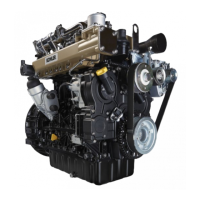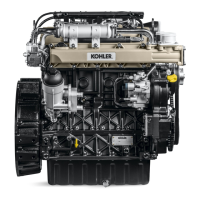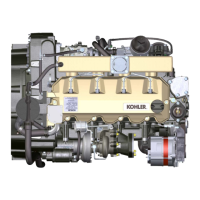
Do you have a question about the Kohler KDI 3404 TM and is the answer not in the manual?
Manual instructions for proper engine use, maintenance, and safety. Must be available for reference.
Details on locating and identifying the engine's name plate for manufacturer and serial number information.
Explains the information presented on the engine's name plate related to EPA regulations and emission control.
Illustrates and identifies main internal engine components and references for understanding engine operation.
Identifies external engine components in the base configuration, with illustrations and references.
Provides detailed specifications and operating parameters for the KDI 3404 TM engine.
Presents the overall dimensions of the engine in millimeters with visual aids.
Details engine performance metrics, including power output and fuel consumption under various conditions.
Covers oil classification, recommended types, and important usage notes for engine lubrication.
Information on diesel fuel types, low-temperature usage, biodiesel, and emission-related installation instructions.
Specifies the technical requirements and composition for engine coolant.
Outlines the recommended battery types based on ambient temperature conditions.
Details the schedule for preventive maintenance, including cleaning, checking, and replacement intervals.
Describes the engine's fuel supply system, including components and important handling precautions.
Explains the engine's lubrication circuit with diagrams, oil pump details, and oil filter/cooler information.
Details the engine's coolant circuit, including pump, thermostatic valve, and radiator components.
Covers the intake and exhaust systems, including intercooler, turbocharger, and EGR components.
Outlines the engine's electrical wiring, connectors, and sensor/switch functionalities.
Describes various sensors and switches used in the engine system, including fuel filter water sensor and coolant temperature sensor.
Details key electrical components such as the alternator, starter motor, and cold starting device.
Explains the engine's timing system, components identification, and hydraulic tappet operation.
Provides guidance on the proper handling of critical engine components like the injection pump, injector, and turbocharger.
Details operational rules, installation, and replacement procedures for the turbocharger.
Essential pre-operation checks and manual reading instructions for safe engine use.
General safety rules, intended use, and user responsibilities for operating and maintaining the engine.
Notes for OEMs and end-users regarding engine installation, modification, and safe operation.
Explains various safety signals, warnings, and protective guards found on the engine and in the manual.
Provides information on accidental start, hot parts, rotating parts, exhaust gases, and electrical shock hazards.
Guidelines for minimizing environmental impact, proper fluid disposal, and compliance with regulations.
Illustrates the placement of safety signals on the engine for operator awareness.
Procedures for protecting engines not in use for extended periods, up to and over six months.
Steps to follow for storing the engine for up to six months, including environmental checks.
Detailed procedure for extending engine storage protection beyond six months.
Instructions for safely starting an engine after it has been stored for a period.
Procedures for safely draining and discharging engine coolant, with warnings about pressure and temperature.
Instructions for draining engine oil, emphasizing safety precautions and proper disposal methods.
Detailed guide for replacing injectors and the injection pump, including disassembly and sealing procedures.
Step-by-step instructions for the disassembly and assembly of the engine's coolant pump.
Procedures for replacing the oil vapour separator, covering both disassembly and assembly steps.
Instructions for replacing the oil cooler unit and the oil filter cartridge, with detailed steps for each.
Guide for replacing the fuel filter, including disassembly and assembly procedures.
General recommendations and important precautions to follow before disassembling engine components.
Step-by-step guide for safely disassembling the turbocharger from the engine.
Procedures for disassembling components related to the coolant recirculation system, including the oil cooler manifold and coolant pump.
Instructions for disassembling electrical components like the starter motor, alternator, and sensors.
Steps for removing the exhaust manifold, emphasizing sealing openings to prevent foreign body entry.
Guides for disassembling various parts of the fuel system, including pipes, injectors, and the fuel filter.
Instructions for removing the crankshaft pulley, involving undoing screws and removing the pulley.
Procedures for disassembling the flywheel and flange housing, with warnings about their weight.
Steps for disassembling the oil pump and oil pressure valve from the lubrication circuit.
Comprehensive guide for disassembling the cylinder head, including rocker arms, valves, and injector sleeves.
Instructions for disassembling the oil sump, oil suction pipe, and oil drain pipe.
Detailed procedures for disassembling the engine block, covering pistons, connecting rods, timing gears, and crankshaft.
General recommendations for overhauling and tuning engine units, emphasizing safety and proper procedures.
Instructions for checking the crankcase, including oil line checks and cylinder measurements.
Procedures for checking tappets and their housings, measuring dimensions and clearances.
Guidelines for dimensional checks, overhauling, and axial clearance measurement of the crankshaft.
Steps for checking connecting rod and piston dimensions, parallelism, and ring condition.
Procedures for checking cylinder head flatness, valve seats, springs, and guides.
Details on checking the oil pump's dimensional and visual aspects, and verifying the oil pressure valve length.
Defines the "BASE CONFIGURATION" and refers to components described in Chapter 11.
Provides general recommendations and guidelines for assembling engine components, referencing special tools.
Detailed steps for assembling the engine block, including crankshaft bushings, tappets, and spray nozzles.
Instructions for assembling the oil sump unit, covering drain pipes, suction pipes, and the oil sump itself.
Procedures for assembling the cylinder head, including valve stem gaskets, injector sleeves, and valve components.
Steps for assembling the lubrication circuit, focusing on the oil pressure relief valve and oil pump.
Instructions for assembling the flange unit, including the bell housing and flywheel with safety warnings.
Procedures for assembling the high-pressure injection pump, injectors, fuel return pipes, and fuel filter.
Steps for assembling the crankshaft pulley onto the crankshaft, including lubrication and tightening.
Instructions for assembling the coolant circuit, covering the thermostatic valve, coolant pump, and oil cooler hoses.
Steps for assembling the exhaust manifold, emphasizing gasket replacement and surface checks.
Procedures for assembling the turbocharger, including component checks and gasket replacement.
Instructions for assembling electrical components like sensors, alternator, and starter motor.
A comprehensive table detailing tightening torques and sealant recommendations for various engine components.
Instructions for checking and filling engine oil, including dipstick usage and level checks.
Procedures for checking and filling engine coolant, with emphasis on safety and proper level maintenance.
Steps for replacing the heater component, including disassembly and assembly procedures.
Instructions for replacing the air filter cartridge, involving cover removal and cartridge insertion.
Procedures for replacing components within the cooling circuit, such as the radiator, fan, and hoses.
Step-by-step guide for regulating the Waste Gate opening valve, including pressure checks and adjustments.
Instructions for checking the air filter cartridge and housing for cleanliness and damage.
Procedure for checking the oil steam separator and its connections for proper function and leaks.
Guidelines for inspecting rubber hoses and manifolds for cracks, tears, or leaks.
Method for checking all main engine components and their contact surfaces for oil leakages.
Procedure for checking engine oil pressure at different temperatures and speeds.
Provides information and references for specific tools required for manual operations, including a link to a manual.
A guide to troubleshooting engine failures by correlating possible causes with observed symptoms and anomalies.
Defines common symbols and units of measurement used throughout the manual for clarity.
